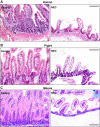Animal models of gastrointestinal and liver diseases. Animal models of necrotizing enterocolitis: pathophysiology, translational relevance, and challenges
- PMID: 24763555
- PMCID: PMC4042110
- DOI: 10.1152/ajpgi.00422.2013
Animal models of gastrointestinal and liver diseases. Animal models of necrotizing enterocolitis: pathophysiology, translational relevance, and challenges
Abstract
Necrotizing enterocolitis is the leading cause of morbidity and mortality from gastrointestinal disease in premature infants and is characterized by initial feeding intolerance and abdominal distention followed by the rapid progression to coagulation necrosis of the intestine and death in many cases. Although the risk factors for NEC development remain well accepted, namely premature birth and formula feeding, the underlying mechanisms remain incompletely understood. Current thinking indicates that NEC develops in response to an abnormal interaction between the mucosal immune system of the premature host and an abnormal indigenous microflora, leading to an exaggerated mucosal inflammatory response and impaired mesenteric perfusion. In seeking to understand the molecular and cellular events leading to NEC, various animal models have been developed. However, the large number and variability between the available animal models and the unique characteristics of each has raised important questions regarding the validity of particular models for NEC research. In an attempt to provide some guidance to the growing community of NEC researchers, we now seek to review the key features of the major NEC models that have been developed in mammalian and nonmammalian species and to assess the advantages, disadvantage, challenges and major scientific discoveries yielded by each. A strategy for model validation is proposed, the principal models are compared, and future directions and challenges within the field of NEC research are explored.
Keywords: TLR4; animal model; innate immunity; microflora; necrotizing enterocolitis.
Copyright © 2014 the American Physiological Society.
Figures



References
-
- Afrazi A, Branca MF, Sodhi CP, Good M, Yamaguchi Y, Egan CE, Lu P, Jia H, Shaffiey S, Lin J, Ma C, Vincent G, Prindle T, Jr, Weyandt S, Neal MD, Ozolek JA, Wiersch J, Tschurtschenthaler M, Shiota C, Gittes GK, Billiar TR, Mollen KP, Kaser A, Blumberg R, Hackam DJ. Toll like receptor 4-mediated endoplasmic reticulum stress in intestinal crypts induces necrotizing enterocolitis. J Biol Chem 289: 9584–9599, 2014 - PMC - PubMed
-
- Baregamian N, Song J, Bailey CE, Papaconstantinou J, Evers BM, Chung DH. Tumor necrosis factor-alpha and apoptosis signal-regulating kinase 1 control reactive oxygen species release, mitochondrial autophagy, and c-Jun N-terminal kinase/p38 phosphorylation during necrotizing enterocolitis. Oxid Med Cell Longev 2: 297–306, 2009 - PMC - PubMed
Publication types
MeSH terms
Grants and funding
LinkOut - more resources
Full Text Sources
Other Literature Sources

